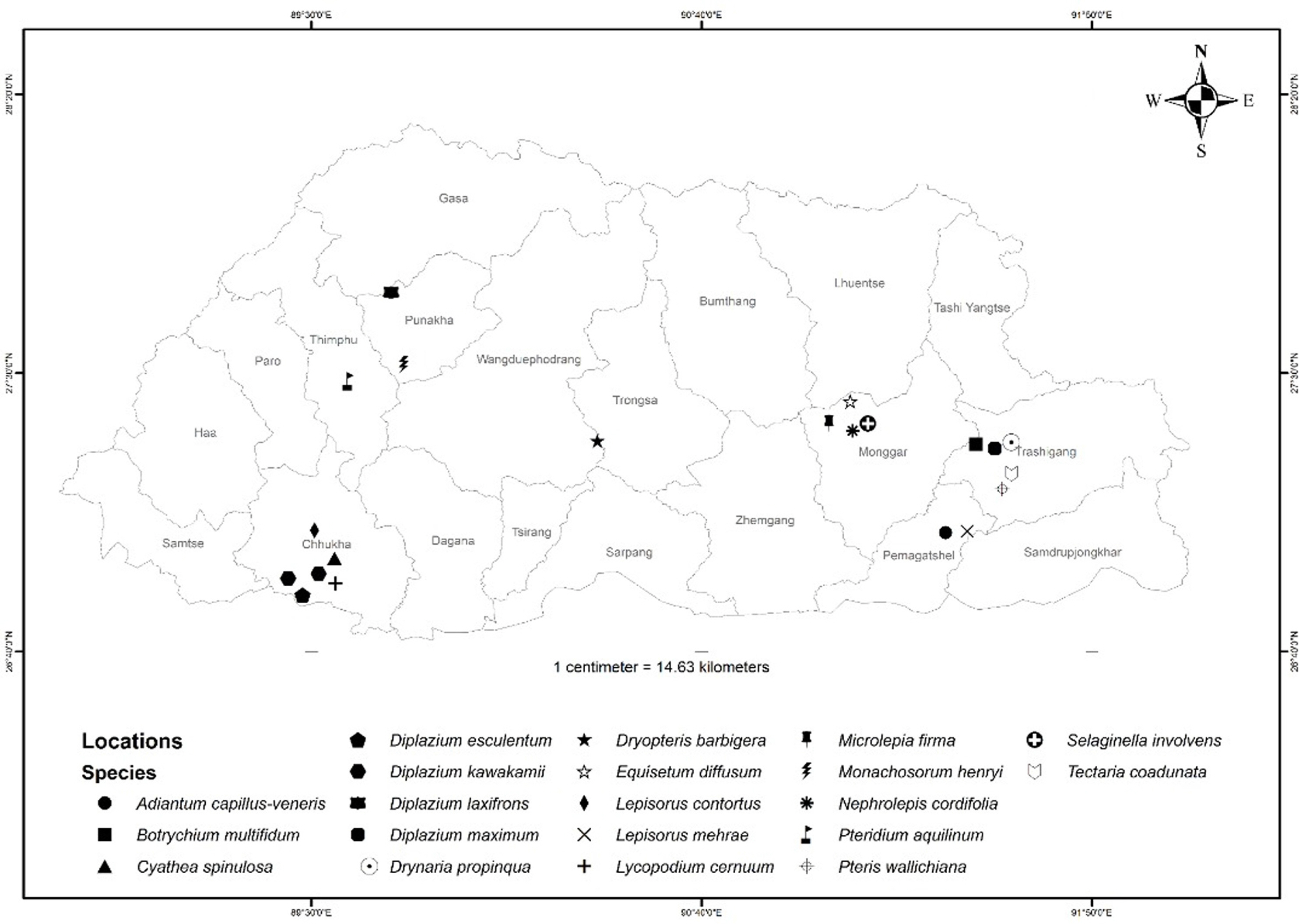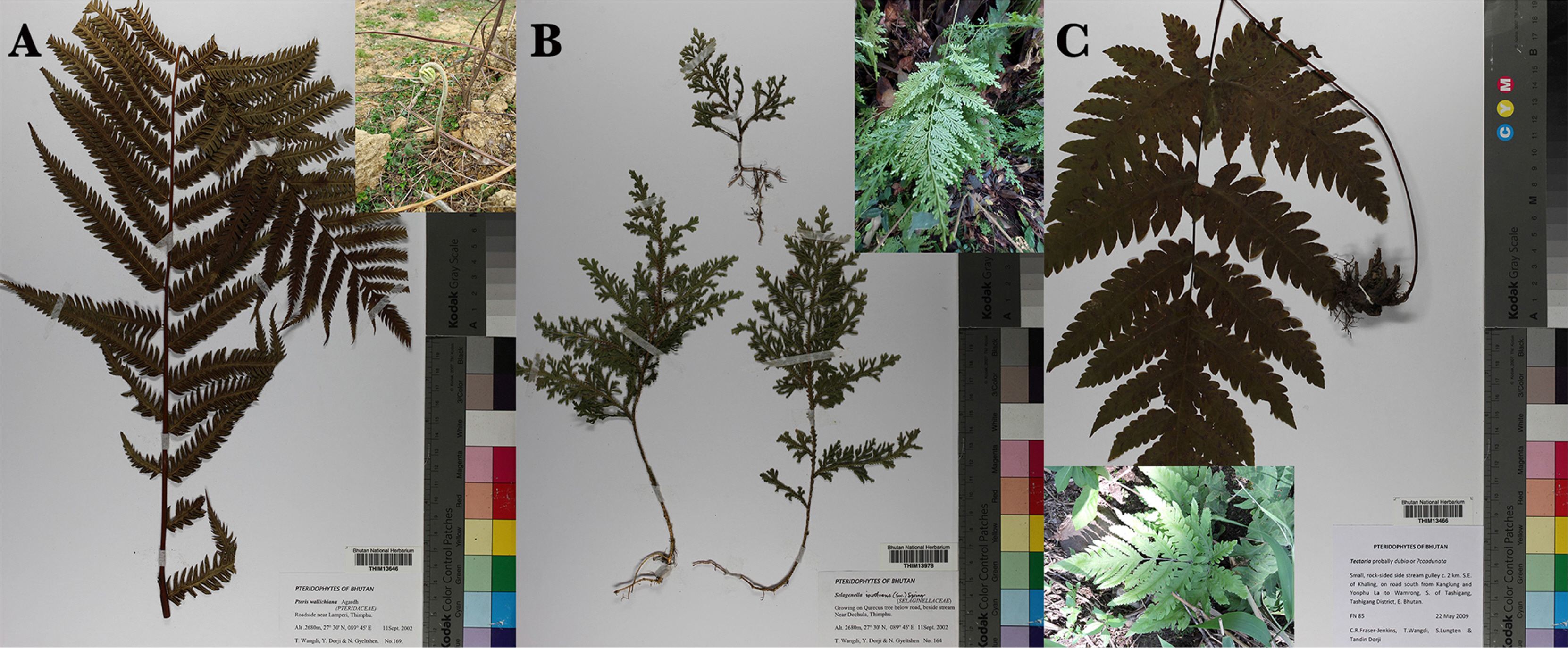Enumeration of edible and useful ferns (Pteridophytes) in the Bhutan Himalayas
Article information
Abstract
Bhutan is endowed with rich biodiversity with several edible and useful fern species. Ferns have been used by local communities for centuries as vegetables, ethnobotanical artifacts, and as medicines. Owing to the limited study of edible and useful pteridophytes in the country, the knowledgebase remains poor. In this study, we attempt to document edible and useful fern species in the country scientifically while also providing an annotated checklist.
INTRODUCTION
There are about 12,000 species of pteridophytes found in the world (Christenhusz and Byng, 2016). The Pteridophytes (Monilophyte and Lycophyte) flora of Asia is remarkably rich as demonstrated by the fact that an estimated 4500 species, more than one-third of the world’s diversity, occurs in Southeast Asia alone and among these 101 threatened pteridophytes species occur in South Asia (Ebihara et al., 2012). The number of species occurring from the unexplored sites are likely to be supplemented on the existing checklist. The diversity of pteridophytes in Bhutan are relatively rich due its biogeographic linkages to the Eastern Himalaya and Palearctic region and also the climate variation indicating the wet monsoon with extensive high altitude in high Himalayan areas, and subtropical forest in low altitude.
In Bhutan, ferns are distributed all over the country from east to west and low land Terai to high altitude Himalayas. Ferns are found in various habitats like epiphytes, terrestrial, lithophytes, rare aquatic, with high variations in altitudinal ranges. High fern diversity is recorded mostly in mid elevation to the lowest altitude range in Bhutan; however, pteridophytes (ferns and lycophytes) flora remain as one of the least explored groups and understudied. The Flora of Bhutan does not report any pteridophytes. Thus, limited literatures are available in Bhutan on diversity of edible ferns, ethnobotanical usages of ferns and other pteridophytes in general.
Bhutan has rich traditional knowledge associated with the biological resources, and used and practiced by the local communities over generations (Fig. 1). Almost all the local communities living in rural areas depend upon the natural resources for food and medicine in their daily life. The country’s forests also harbor large percentage of non-wood forest products ranging from bamboos, cane shoots, lemongrass, essential oils, mushrooms, ferns, resins, medical and aromatic plants, natural dyes, bees and insects, tubers, traditional fish products, and host of others products (Tobgay, 2008).
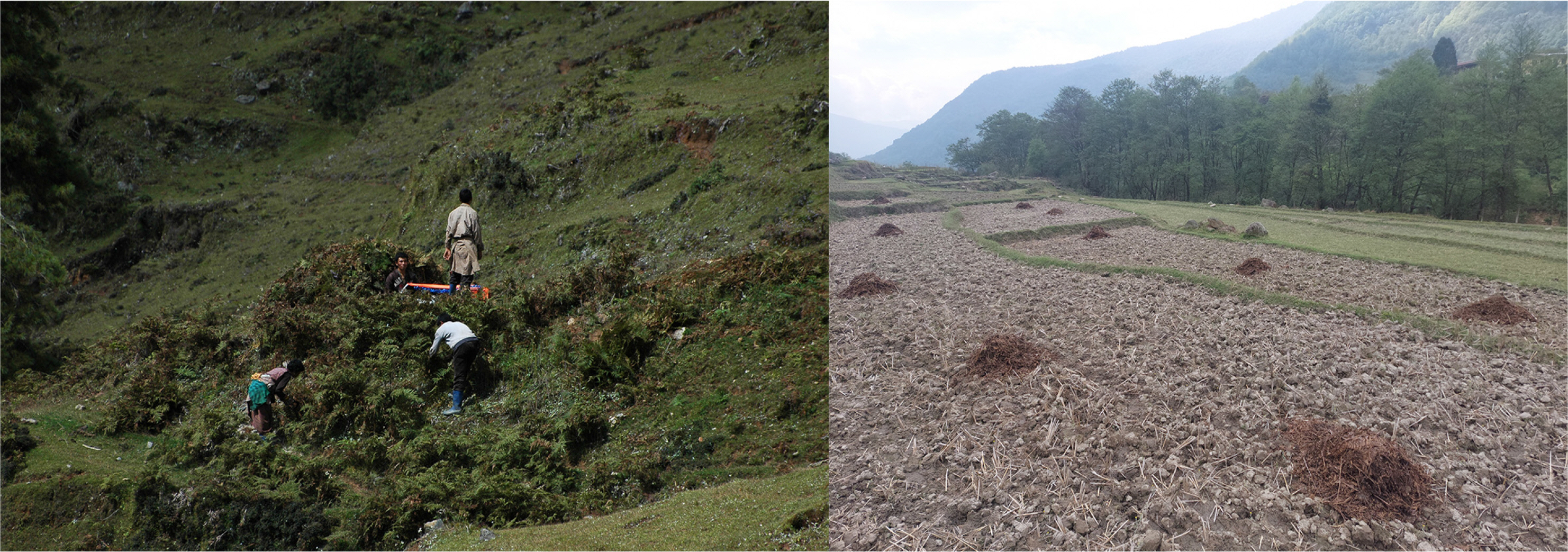
Pterdium aquilinum. A. Pterdium aquilinum collection by farmers for animal bedding (Photo © Phuentsho). B. Pteridium aquilinum is used in the paddy field with cow dung as an organic manure (Photo © Rinchen Dorji)
Wild edible plants are uncultivated plants found in the wild forms that have nutritive values and can be used for fulfilling dietary requirements (Dangol et al., 2017). Inadequate study focusing on ethnomedicinal use of Pteridophytes has been reported and the limited traditional use of pteridophytes as food and medicine is being documented in Bhutan with some of the fern species being used as food listed in non-wood forest products. Investigations of the traditional uses of edible wild plants in Bhutan were carried out from 2005 to 2010 in a joint research program between Shinshu University and the Ministry of Agriculture of Bhutan (Matsushima et al., 2012); however, there is limited information on the traditional use of Pteridophytes group being used by the local communities. This study attempts to document and examine the information on wild edible ferns, their family names, local names, habits, plant parts and uses through various means of interaction with the local communities.
Traditional uses of Pteridophytes as food and medicine
As reported by Fraser-Jenkins et al. (2009), some species of edible ferns have been recorded which are commonly consumed by local people, and some are available in the market. Local communities living in particular areas depend on the use of wild plants or plant parts to fulfill their needs and often have considerable knowledge of their uses. Local communities generally depend on nearby forest areas to supply their needs (Acharya, 2010).
In Bhutan, a few species of ferns are being used to develop traditional medicines and local healing products. Ferns form a part of vegetables in many communities across the country. Their popularity is rising because of their high nutritional content such as Vitamin C, protein, and iron (Chettri, 2018). Valuation of Pteridophytes uses as ethnobotany are inadequate in documenting although some local communities have been utilizing it for a long time as a source of food and traditional medicinal purpose. Eating edible wild plants is one of the important traditions in the food culture of Bhutan. Gathering edible wild plants also leads to forest conservation, and selling edible wild plants at local markets promotes the socio-economic development of communities (Matsushima et al., 2012).
Through this study, the number of species are being added in the consumable list and revealed that there is a wealth of knowledge about the food in the local community. Most of the edible ferns found in Bhutan are distributed in different geographical regions particularly towards low-altitude to midaltitudinal zones.
This study aims to bring the diversity of edible ferns and checklist including the ethnobotanical uses in the communities. Even though there are only a limited number of edible ferns species that have been assessed and included in the non-wood forest product, some neighboring countries have already published some species which are already in the checklist. We have also attempted to include possible edible ferns species by different regions in the countries based on the field data and information.
MATERIALS AND METHODS
The herbarium specimens of all edible species were collected in Bhutan within the wide range of altitudinal distribution. Collections are being assessed for the diversity of edible ferns specimens from the existing fern herbarium specimens from the National Herbarium. Collections of the edible ferns species were made mostly from the low to midaltitude range with the moisture content relatively high and also few species are grown in the forest partially mixed with broad-leaved forest falling under the subtropical and temperate zonation of Bhutan (Fig. 2).
Assessments to find the diversity of edible fern records have been carried out based on the field data and information, literature reviews, and herbarium collections. Through assessment of the collection history of edible ferns, places were identified to enumerate the diversity and intensity of collection. Transect sampling plot method was applied to find out the diversity of edible ferns and associate species. Due to rugged terrains in some of the identified sampling sites, adopting the same methodology was challenging and had to find out different means of method for the collection of diversity data. For the plot identification and locating places, SW maps and Epicollect5 android apps are used for the data collection. Determination of species was conducted from the existing fern specimens collected and literature.
Ethnobotanical and medicinal uses of the fern species were obtained through random interviews in local communities during the specimen collections in the country. In addition, various literatures and reports were examined to source related information (e.g., Wangchuk and Samten, 2009).
The collection and processing of herbarium specimens was carried out using the National Herbarium (THIM) protocol as followed in other flora groups. The specimens collected represent whole healthy plants with the scales, sporangia (fertile parts), hairs, and rhizomes. The collection materials used in the field are plants press, old newspaper, bloating paper, cardboard, measuring tapes, magnifying lens, GPS, and field notebook. The field data such as GPS coordinates, altitude, habitat, description of plants, date of collection, collectors, and locations were noted to furnish in the herbarium specimens details.
RESULTS AND DISCUSSION
The wild edible and ethnobotanical plants inventory
This paper provides an annotated checklist with information on ethnobotanical uses of wild edible and useful ferns species (Table 1). Pteridophytes are used for multi-purpose in different ways by various societies, deferring from place to place. Around 5% of ferns are edible among the 412 fern species in the country (Gyeltshen et al., 2018). Other than food and medicinal purposes, Pteridium aquilinum (Fig. 1) and Pteris wallichiana are used as animal bedding where it is turned into good manure after mixing with dung. Equisetum diffusum is used as a tool to wipe out evil spirits by the local shaman usually performed by indigenous. Lycopodium cernuum is used for decorating gates, covering the walls during celebrations, and even in ritual ceremony.
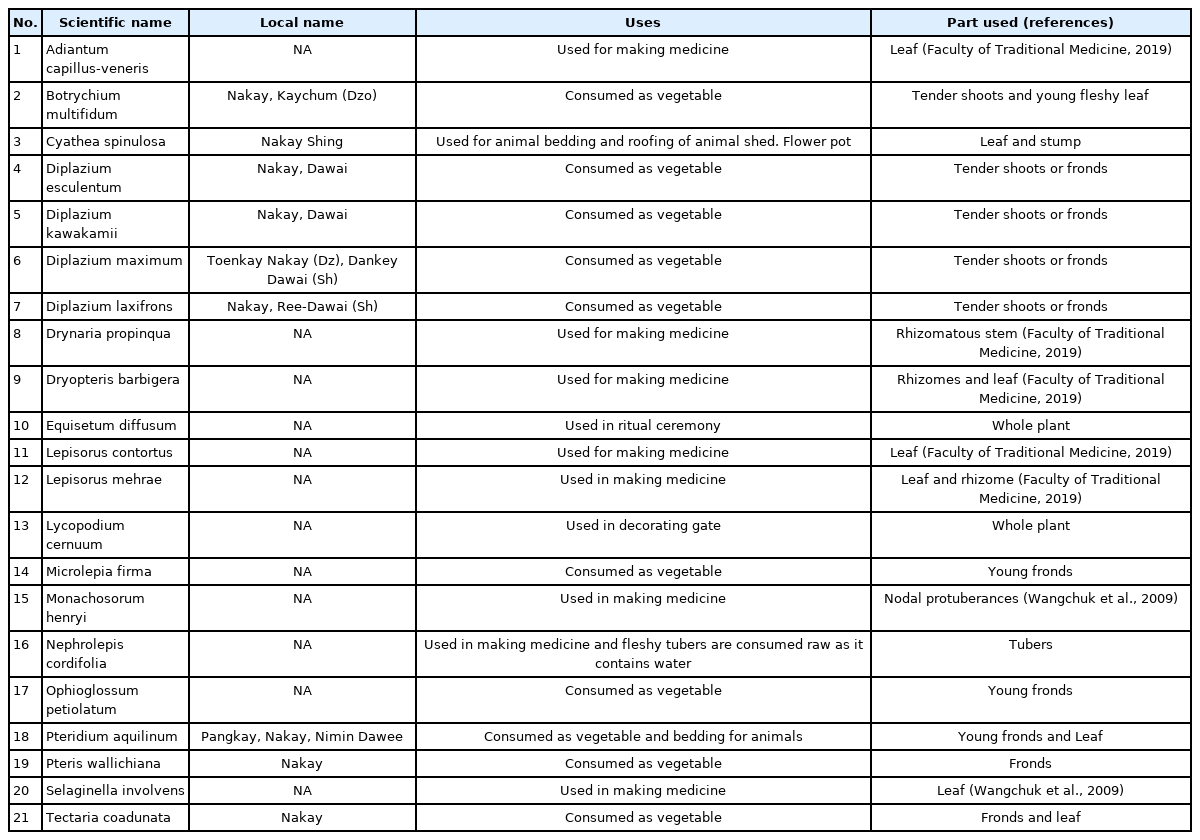
List of recorded edible and ethnobotanical Pteridophytes from Bhutan with information on its general uses and part used
The number of edible ferns and its ethnobotany practices are listed for 21 species, out of which three species are used only for the purpose of bedding for domestic animals, decorating gates and ceremony, used in performing rituals, and firewood including flower pot from the stump. Additionally, eight species are used in making medicine in the Department of Traditional Medicine Services. However, 10 species are mostly consumed as vegetables and they are commercially available in the market. Diplazium esculantum, D. maximum, and D. stocklizo are harvested heavily from the forest for commercial use and make good income from selling in the market as it is considered as the most delicious wild food by the common people in the urban areas. Adiantum capillus-veneris, Drynaria propinqua, Dryopteris barbigera, Lepisorus contortus, L. mehrae, Monachosorum henryi, Nephrolepis cordifolia, and Selaginella involvens are used to make medicine in Department of Traditional Medicine Services. Several fern species reported in Bhutan such as Athyrium strigillosum, Deparia boryana, Diplazium spectabile, D. stoliczkae, Dryopteris cochleata, Polystichum squarrosum, Lygodium flexuosum, L. japonicum, Botrychium lanuginosum, Ophioglossum reticulatum, Osmunda claytoniana, and Thelypteris nudata are common edible ferns in Nepal (Ojha et al., 2021), but it is not recorded and listed in the category of edible species in Bhutan. Similarly, some of the species like Diplazium esculantum, D. maximum, D. stoliczkae, Cyathea spinulosa, Dennstaedtia appendiculata, Dryopteris cochleata, Equisetum arvense, E. ramosissimum, Diplopterygium giganteum, Lycopodiella cernua, L. japonicum, Lygodium flexuosum, L. japonicum, Oleandra wallichii, Botrychium lanuginosum, B. lunari, B. multifidum, Ophioglossum petiolatum, O. reticulatum, Drynaria quercifolia, Lepisorus thunbergianus, Polypodiodes amoena, Adiantum caudatum, A. incisum, Aleuritopteris albomarginata, A. anceps, A. bicolor, Pteris aspericaulis, Tectaria coadunata, and Thelypteris nudata are used as traditional medicine in Nepal which are also reported from Bhutan (Fig. 3). Ophioglossum petiolatum is used as an edible species (Fraser-Jenkins et al., 2009) but the distribution is not yet known.
Materials examined for edible and useful fern species
-
Adiantum capillus-veneris L. (Fig. 3A)
Specimens examined: BHUTAN. Pemagatshel District, Between Denche and Yurung Drang, elev. 760 m, 27.02217N, 91.39563E, 20 Aug 2007, T. Wangdi 472 (THIM 14980). CHINA. 36.519977N, 103.891767E, 1 Jan 1910, P. Michel 1010 (type: BM 001044128).
-
Botrychium multifidum (S. G. Gmel.) Rupr. (Fig. 3B)
Specimens examined: BHUTAN. Trashigang, Kanglung Gewog, Kanglung, elev. 1,860–1,900 m, 27.28682N, 91.52367E, 25 Sep 2003, Mohan Chhetri 24 (THIM 13274).
U.S.A. Minnesota: elev. 1,166 m, 48.45477N, 96.1920W, 10 Oct 2015, Dustin R.J. Graham DRJG61, 962664; Hubbard, 46.811111N, 94.774167W, 17 Aug 2013, Otto Gockman & Amelia Krug 18802.
-
Cyathea spinulosa Wall. ex Hook. (Fig. 3C)
Specimens examined: BHUTAN. Chukha, Bongo Gewog, elev. 1,984 m, 26.92177N, 89.52293E, 15 Oct 2006, C.R. Fraser-Jenkins 31771 (THIM 12383). CHINA. 36.519977N, 103.891767E, 1 Mar 1909, Pierre Julien Cavalerie 3384 (type: BM 001039929).
-
Diplazium esculentum (Retz.) Sw. (Fig. 3D)
Specimens examined: BHUTAN. Chukha, Phuntsholing, Roadside, about 4.5 km above Pasakha on Manitar road, elev. 400 m, 26.83500N, 89.47397E, 2 Oct 2005, T. Wangdi 236 (THIM 12101).
INDIA. Assam, Moran, Debruhgarh, 25 Oct 1944, C. Sidney (N 00002945).
SRILANKA. Kankaniya Inullah, 24 Mar 1956, D. Chatterjee 513 (NCU 00378125).
-
Diplazium kawakamii Hayata (Fig. 3E)
Specimens examined: BHUTAN. Chukha, Gedu, Sorchen, elev. 1,360 m, 27.10472222N, 89.47305556E, 3 Apr 2005, T. Wangdi 430 (THIM 12120); Chukha, Gedu, elev. 2,090 m, 26.91342N, 89.52701E, 6 Oct 2005. C.R. Fraser-Jenkins 31477 (THIM 12117).
TAIWAN. Li-Shan Taichung County, 29 Nov 1962, C. Feung & M.T. Kao 286; Ila Hsien: Taroko National Park, Near Yungling camp in Picea forest with bamboo understory, elev. 2,500 m, 24.37N, 121.43E, 10 Sep 1991, R.C. Moran 5433.
-
Diplazium laxifrons Rosenst. (Fig. 3F)
Specimens examined: BHUTAN. Punakha, Near Tashithang, north of Punakha, elev. 1,630 m, 27.74007N, 89.73877E, 6 Sep 2007, T. Wangdi 576 (THIM 12253). TAIWAN. Taipei, Feb 1914, U. Faurie 172 (isotype).
-
Diplazium maximum (D. Don) C. Chr. (Fig. 4A)
Specimens examined: BHUTAN. Trashigang, Kanglung geog, Rongthong, elev. 1,845 m, 27.27375N, 91.54251E, 4 Jun 2003, Lekey Khandu 102 (THIM 12280); Chukha, Gongo Gewog, c. 3 km N.E. of Gedu, S. of Chukha from Thimphu to Phuntsholing, S.W. of Bhutan, elev. 1,910 m, 15 Oct 2005, C.R. Fraser-Jenkins 31777 (THIM 12275). INDONESIA. Java, Burangrang, 6.735278S, 107.584722E, CL Blume (type: L 0051552, 908332811).
-
Drynaria propinqua (Wall. ex Mett.) J. Sm. ex Bedd. (Fig. 4B)
Specimens examined: BHUTAN. Kanglung Gewog, Khamgma, elev. 1,698 m, 27.29247N, 91.52264E, 5 Sep 2002, Lhakpa Tshering Tamang 10 (THIM 13156).
NEPAL. Napalia, 1 Jan 1821, N. Wallich 0061364.
-
Dryopteris barbigera (Hook.) Kuntze (Fig. 4C)
Specimens examined: BHUTAN. Wangduephodrang, Black Mountain, Sertsho Lake, elev. 4,232 m, 27.29602687N, 90.35481569E, 22 Aug 2021, R. Dorji et al. R839 (THIM 16868).
ASIA. Falconer (BM 001066068). INDIA. elev. 3,810 m, J. D. Hooker 258 (isotype: K 001080868).
-
Equisetum diffusum D. Don (Fig. 4D)
Specimens examined: BHUTAN. Mongar, Saling Gewog, Between Namling and Yongkola on the way to Mongar from Bumthang, elev. 2,240 m, 27.36128N, 91.11082E, 30 Mar 2007, T. Wangdi 319 (THIM 12778). NEPAL. S.L., Lambert (isotype: BR 0000006971786).
UNITED STATES, Georgia, Fulton, 33.789845N, 84.372635W, 23 Jun 2017, Lorena Endara 1875 (FLAS 267628).
-
Lepisorus contortus (Christ) Ching (Fig. 4E)
Specimens examined: BHUTAN. Chukha, Bongo Gewog, elev. 2,080 m, 26.93617N, 89.50950E, 8 Mar 2005, T. Wangdi 50 (THIM 13194).
INDIA. Northwestern India, Parbati valley, Kangra, Punjab, Mamkam, 8 Jun 1933, W. N. Koelz 4844 (US 1860361).
-
Lepisorus mehrae Fraser-Jenk (Fig. 4F)
Specimens examined: BHUTAN. Pemagatshel, Aney Gonpa, Between Aney Gonpa and Tshelingkhor, elev. 2,190 m, 27.02572N, 91.46058E, 21 Aug 2007, T. Wangdi 521 (THIM 13235) INDIA. Uttar Pradesh, elev. 2,000 m, 22 Sep 1996, C. R. Fraser-Jenkins 24390 (FN 368) (holotype: BM 001022812).
-
Lycopodium cernuum (L.) Pic. Serm (Fig. 5A)
Specimens examined: BHUTAN. Chukha, Darla Gewog, On way to Tala hydropower house, Tala, elev. 1,620 m, 26.86967N, 89.57190E, 1 Sep 2005, T. Wangdi 208 (THIM 13066).
MEXICO. La Ventana, Mpio. Union Juarez, Chiapas, 14 Jan 1992, E. Ventura & E. Lopez 9916 (MA 01-00564147).
SRILANKA. Ceylon, 127343 (type).
-
Monachosorum henryi Christ (Fig. 5B)
Specimens examined: BHUTAN. Thimphu, Kikhorthang gewog, Near Menchuna, elev. 2,320 m, 27.52460N, 89.77633E, 1 Apr 2007, T. Wangdi 410 (THIM 13007). CHINA. Yunnan, Mengtze, mt forest E., elev. 7,000 m, A. Henry 10457 A (type: P 02141945).
-
Microlepia firma Mett. ex Kuhn (Fig. 5C)
Specimen examined: BHUTAN. Mongar, Saling Gewog, Near Yongkola 13 km point, Mongar district, elev. 2,200 m, 27.34865N, 91.11695E, 30 Mar 2007, T. Wangdi 340 (THIM 13287).
PHILIPPINES. Penablanca, Luzon, Cagayan, 16 Mar 1929, M. Ramos 77175 (isotype: K 127931).
-
Nephrolepis cordifolia (L.) C. Presl (Fig. 5D)
Specimens examined: BHUTAN. Mongar, Saling Gewog, Between Namling and Yongkola on the way to Mongar from Bumthang, elev. 1,980 m, 27.32685N, 91.13177E, 30 Mar 2007, T. Wangdi 380 (THIM 14897).
INDONESIA. In Montosis Tengger, Prope Gebeh Klakka, Java, elev. 1,220 m, 7.916667S, 112.916667E, 7 Nov 1844, H. Zollinger 2526 (type: L .3582012).
-
Ophioglossum petiolatum Hook. (Fig 5E)
Specimens examined: WEST INDIES. F. Ballard (type: K 000913131).
TAIWAN. Taipei, elev. 30 m, 22.73333N, 121.13333E, 28 Feb 2011, R. Knapp (P 01187989).
U.S.A. Florida: Taylor Co., 10 Apr 2008, Lucas C. Majure 3076 (USF 223873).
-
Pteridium aquilinum (L.) Kuhn (Fig. 5F)
Specimen examined: BHUTAN. Thimphu, Motithang, Motithang Guest House, elev. 2,240 m, 27.47463N, 89.60938E, 20 May 1971, R. Bedi 5 (THIM 14955).
GREAT BRITAIN. VC28 West Norfolk, Narborough, TF71, 4 Sep 1916, Rev. D. M. Heath; VC21 Middlesex, Hampstead, TQ28, Aug 1861, T. Moore 30-07 (BIRM 25536) .
-
Pteris wallichiana J. Agardh (Fig. 6A)
Specimens examined: BHUTAN. Trashigang, Khaling, Khaling – Kharungla logging road, elev. 2,320 m, 27.16170N, 91.56505E, 17 Aug 2007, T. Wangdi 479 (THIM 13653).
INDIA. Anon (BM 001044207, TYPE).
JAPAN. Jul 1900, U. J. Faurie 4593 (BM 001044207).
-
Selaginella involvens (Sw.) Spring (Fig. 6B)
Specimens examined: BHUTAN. Mongar, Saling gewog, Near Yongkola 13 km point, elev. 2,200 m, 27.34865N, 91.11695E, 30 Mar 2007, T. Wangdi 347 (THIM 13985).
NEPAL. elev. 830 m, 28.253008N, 83.938548E, 1 Jan 1820, N. Wallich 137 (type: BM 001073276).
-
Tectaria coadunata (J. Sm.) C.Chr. (Fig. 6C)
Specimens examined: BHUTAN. Trashigang, elev. 2,086 m, 27.198741N, 91.592724E, 22 May 2009, Fraser-Jenkins et al. FN 85 (THIM 10240).
CHINA. Du Kouy Tcheou, Kuei-Chou Sheng, 13 Feb 1903, J. Cavalerie 872 (type: L 0052155)
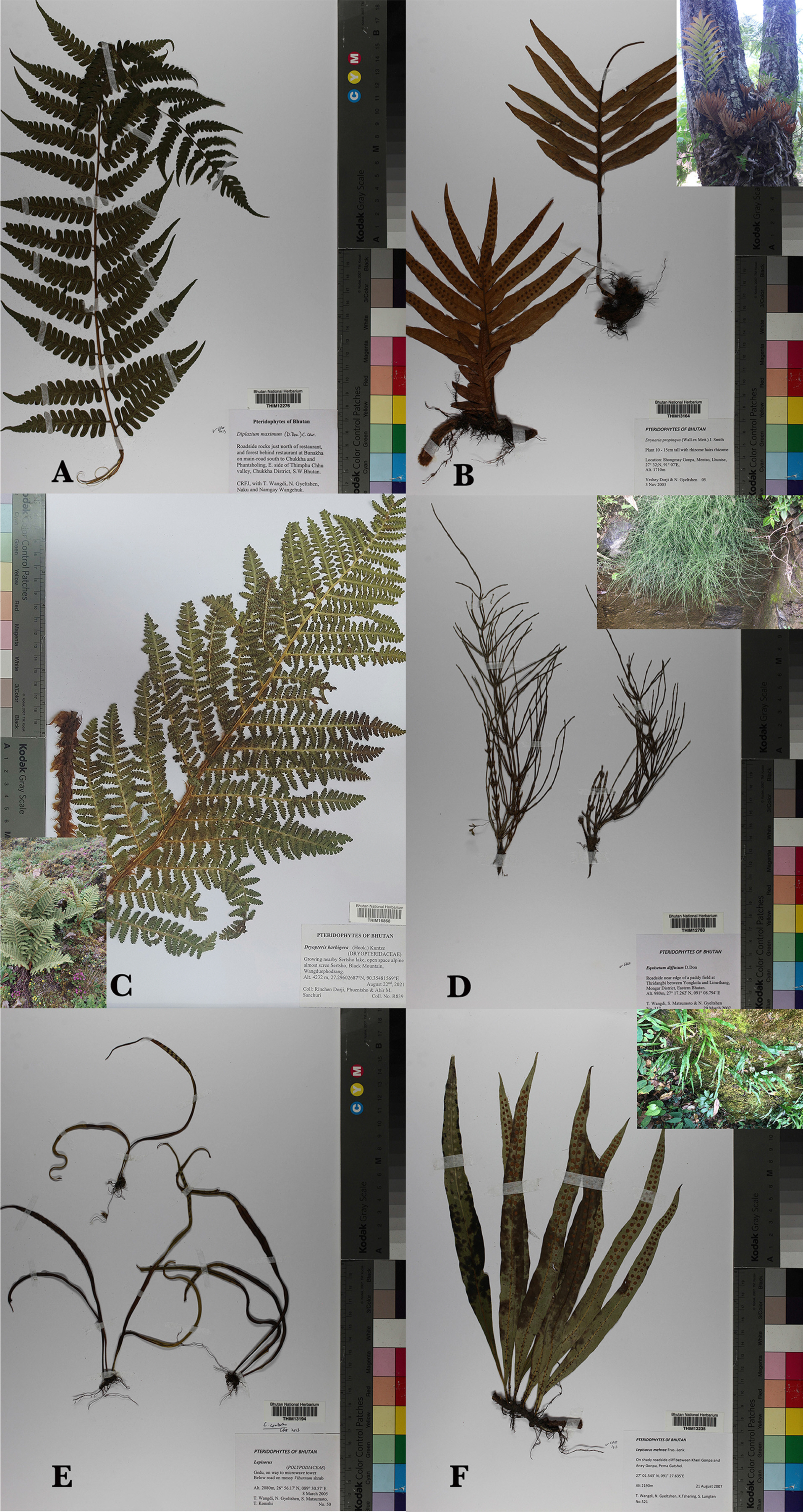
Specimens of fern species. A. Diplazium maximum. B. Drynaria propinqua. C. Dryopteris barbigera. D. Equisetum diffusum. E. Lepisorus contortus. F. Lepisorus mehrae.

Specimens of fern species. A. Lycopodium cernuum. B. Monachosorum henryi. C. Microlepia firma. D. Nephrolepis cordifolia. E. Ophioglossum petiolatum (Specimen Photo © Royal Botanic Garden Kew; Field Photo © Alan Cressler). F. Pteridium aquilinum.
Acknowledgements
We affectionately thank Dr. Karma Dema Dorji, current Program Director, NBC and former Program Director, Dr. Tashi Yangzome Dorji for their constant motivation and guidance. The authors would like to thank National Biodiversity Centre colleagues who always accompanied during assessment and survey of edible fern collection and other associate species. Authors would like to thank whole heartedly to the National Herbarium team for the technical input of the study, always supporting and guiding in collection of fern herbarium specimens and enumerating the edible fern species. Without the support from our local farmers who depend on wild edible plants, the list of edible ferns would not have been able to come out as a journal article. Our heartfelt gratitude goes to the editors and anonymous reviews of this article. We thank the Royal Government of Bhutan for the financial support to conduct field trips.
Notes
CONFLICTS OF INTEREST
The authors declare that there are no conflicts of interest.

